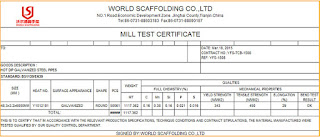Understanding Mill Test Reports: A Comprehensive Guide
If you work in industries such as construction, manufacturing, or engineering, you've likely come across the term "Mill Test Report" (MTR) at some point in your career. MTRs are crucial documents that provide essential information about the quality and characteristics of the materials you are using. In this article, we will explore what a Mill Test Report is, why it is important, and how to interpret the information it contains.
What is a Mill Test Report?
A Mill Test Report, also known as a Certified Mill Test Report, is a quality assurance document provided by a manufacturer or supplier of raw materials. It is generated during the production process to ensure the materials meet the required specifications and standards.
The MTR provides detailed information about the material's chemical composition, mechanical properties, and any additional testing conducted. It serves as proof that the material has been tested and meets the necessary quality standards for its intended use.
Why are Mill Test Reports Important?
Mill Test Reports play a crucial role in ensuring quality control and product conformity. They provide essential information for engineers, manufacturers, and end-users to verify the suitability and reliability of the materials they are working with.
Here are some key reasons why MTRs are important:
- Verification of Material Properties: MTRs reveal the chemical and physical properties of the raw materials, including composition, strength, and durability. This allows engineers and manufacturers to ensure that the materials meet the required specifications.
- Quality Assurance: MTRs guarantee that the materials used in manufacturing processes are of high quality and meet industry standards. They provide evidence of compliance, making them a valuable tool for quality control audits and inspections.
- Traceability: MTRs provide crucial traceability information, including the manufacturer's name, heat or lot number, and other relevant details. In case of any issues or failures, this information helps identify and rectify the problem effectively.
- Supply Chain Transparency: MTRs enhance supply chain transparency by ensuring that suppliers deliver materials that meet the specified requirements. This helps establish trust and promotes accountability throughout the supply chain.
- Compliance with Regulations: Many industries, such as oil and gas, aerospace, and construction, have strict regulatory standards. MTRs help ensure compliance with these regulations, preventing potential accidents or failures that could result from using substandard materials.
How to Interpret a Mill Test Report?
Understanding the information presented in a Mill Test Report is essential to make informed decisions and assess if the materials are suitable for your application. Here are some key aspects to consider when interpreting an MTR:
- Chemical Composition: The MTR provides a detailed breakdown of the chemical composition of the material, including elements and their respective percentages. Ensure that the composition aligns with your project's requirements.
- Mechanical Properties: This section outlines the mechanical characteristics of the material, including tensile strength, yield strength, and hardness. Compare these values with the specifications to ensure they meet the required standards.
- Testing Procedures: MTRs often include information about the testing procedures performed on the material, such as heat treatment, impact tests, or non-destructive testing. Assess whether the tests conducted align with industry standards and the specific application requirements.
- Surface Condition: The MTR may provide details about the surface finish, coating, or any other surface treatment applied to the material. Ensure that these aspects align with your project's needs, especially if aesthetics or corrosion resistance are vital.
- Compliance and Certification: Look for any certification stamps or statements confirming that the material complies with the required standards, such as ASTM, ISO, or ASME.
Remember, if you have any doubts or require further clarification about the information provided in a Mill Test Report, reach out to the manufacturer or supplier for additional assistance.
In Conclusion
Mill Test Reports are crucial documents for ensuring material quality, compliance, and traceability. By understanding how to interpret the information they contain, you can make informed decisions about the materials you use, enhancing the overall quality and safety of your projects. Always request and review MTRs whenever you receive materials to ensure they meet your requirements and industry standards.

No comments:
Post a Comment